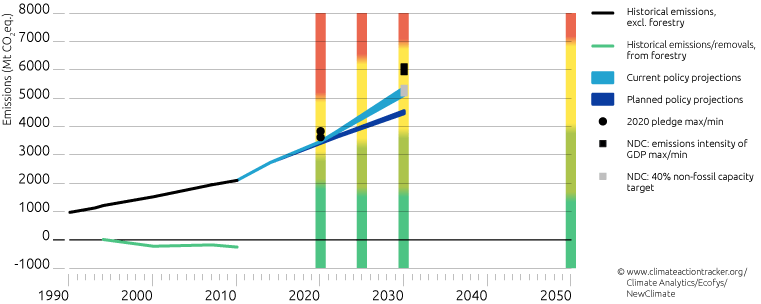When it signed the Paris Climate Agreement in 2016, China pledged that it’s greenhouse-gas emissions would peak no later than 2030 and would plunge after that, while the United States set a lackluster emission-reduction target that it intended to dramatically improve over time, and India pledged to slow growth in emissions by ratcheting up its renewable-sector.
Now, both China and India have beaten their targets and have room to ratchet up ambitions – which is a key feature of the Paris Agreement – but the United States won’t reduce emissions at all if President Donald Trump implements his proposed policies, according to new analysis from the Climate Action Tracker, published in Bonn.
All countries are still rated “medium” on the CAT scale, which goes from “inadequate” to “role model”, but CAT said in a statement that if it were to rate the current policies of the Trump Administration as the country’s climate action plan, or “NDC” (Nationally-Determined Contribution), it would move it from “medium” to “inadequate” on its rating scale.
“
The highly adverse rollbacks of US climate policies by the Trump Administration, if fully implemented and not compensated by other actors, are projected to flatten US emissions instead of continuing on a downward trend.
Niklas Höhne, NewClimate Institute
India
India wins points for canceling coal-fired “ultra-mega power projects.”
“The ongoing reduction in coal use for the third year in a row has had a major impact, and, if they were to continue at similar rates in the next decade, total Chinese GHG emissions will only show a very slight increase in the period 2015–2030, and essentially plateau at close to 12.0 GtCO2e/year,” the authors write. “However, the absence of comparable commitments on other, non-CO2, gases means that total greenhouse gas emissions could continue to increase until at least 2030.”
The country summary is quite accessible and available here.

China
China is continuing to reduce its coal and carbon dioxide emissions, the ongoing growth of renewable energy and slowdown of coal in India is the most important development underway globally today.
“Our analysis shows that China will achieve both its 2020 pledge and its 2030 plans,” the authors write. “Current policy projections show that emissions in 2030 could lie in the range of 12.2–13.7 GtCO2e, implying that China may well overachieve the target levels implied by its NDC with its current policies.”
The country summary is available here.

United States
The United States remains a wildcard under President Donald Trump. While cities and states have vowed to move forward on climate action, federal policies could negate any progress, keeping the country at its current levels through 2030.
“The highly adverse rollbacks of US climate policies by the Trump Administration, if fully implemented and not compensated by other actors, are projected to flatten US emissions instead of continuing on a downward trend,” said Prof Niklas Höhne, of NewClimate Institute.
The country summary is available here.

The shift represents a stunning turn-around.
“Five years ago, the idea of either China or India stopping—or even slowing—coal use was considered an insurmountable hurdle, as coal-fired power plants were thought by many to be necessary to satisfy the energy demands of these countries,” said Bill Hare of Climate Analytics. “Recent observations show they are now on the way towards overcoming this challenge.”
Critics of the Trump Administration have pointed out that jobs in the renewables and environmental restoration sectors dwarf those in coal, which is falling out of favor around the world.
“In the last ten years the energy market has transformed: the price of renewable energy from wind and solar has dropped drastically. Renewables are now cost-competitive and being built at a much faster rate than coal fired power plants,” said Yvonne Deng of Ecofys.
This story was published with permission from Ecosystem Marketplace.

















